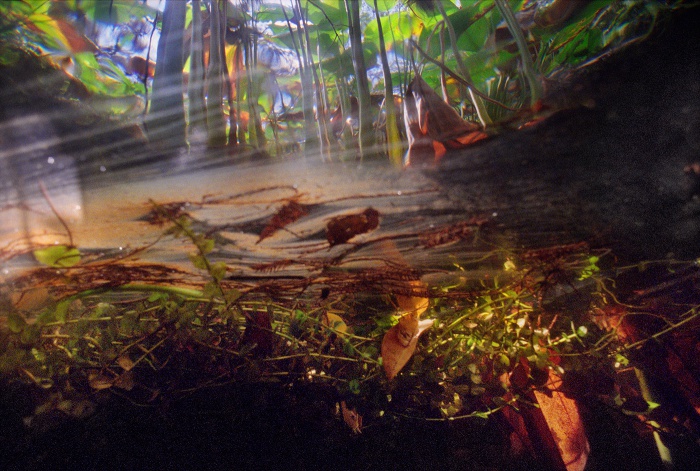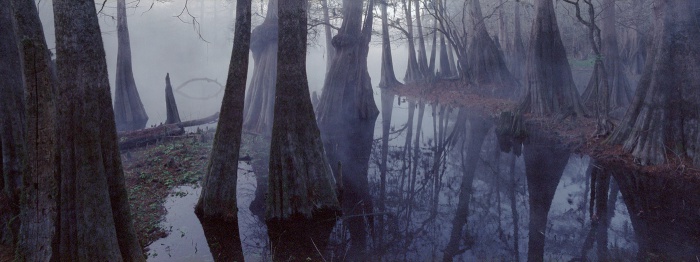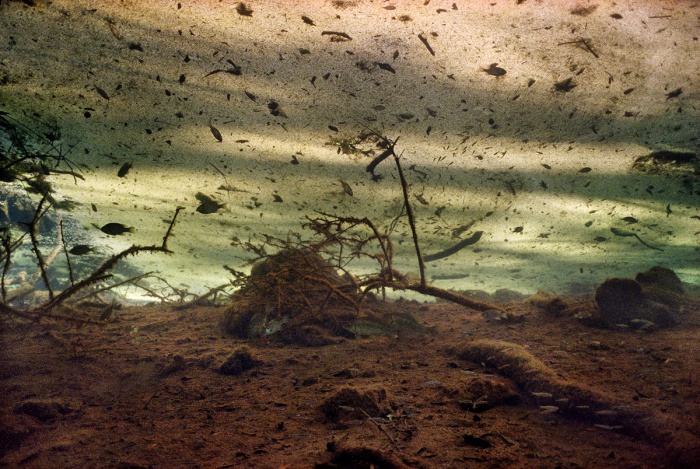Photographer Karen Glaser is best described as a photographer of water. Declining to be “pigeonholed,” Glaser pulls from the genres of landscape, underwater, fine art, street, and documentary photography in her approach to capturing the complicated, beautiful, and diverse aquatic landscapes of Florida.
Spanning decades, Karen Glaser’s work photographing Florida’s fresh waters resulted in two separate but highly interrelated series titled “Springs” and “Swamps.” After her interest in the springs of Florida was piqued by a previous project about Florida’s Manatees, Glaser was later awarded several artist-in-residencies from Florida organizations such as the Big Cypress National Preserve and the Everglades National Park. This enabled Glaser to expand her reach to the swamps of southern Florida, gaining access to some of the most beautiful-and most endangered-fresh water areas in the state.

Glaser’s work in Florida’s springs and swamps is inexorably tied to the fragility of their existence; threatened by pollution from a variety of factors stemming from human presence, even protected aquatic areas are at risk for being polluted by the rivers and streams that feed into them. Glaser points to the Ichetucknee River as an example of this; a vital connection to the springs of northern Florida, the river is currently the focus of activism by the Ichetucknee Alliance, a nonprofit whose work strives to create “a healthy Ichetucknee River System that is preserved and protected for future generations.” Glaser describes these fresh water areas as “essential” adding, “Water is essential for all of our lives, but it’s really been essential and [fresh water] is very endangered in these places. These are really important issues right now because water is a mess in this world, actually. There’s only 1% of potable water out there, and 70% of the earth is covered by water. I mean, water is our stage to life…and you don’t want people to just think of water as a glass of Perrier…you want people to get the big situation.”


While Glaser is quick to point out that her background is in the arts, and not in science, she says she has had to educate herself about the environmental factors facing the subject matter she has presented throughout her career, as relying purely on the visual aspect of a project is not enough in the face of complex environmental issues. Discussing a former project photographing Manatees, Glaser says she was initially just interested in “their form” but soon discovered that many of them had injuries and scars from boat propellers, and was pushed to further research their relationship with water and the human presence which threatened it. Eventually this led her to turn her attention solely to their habitat, the springs of Florida.
From her start photographing springs in northern and central Florida for “Springs” Glaser says she was later drawn visually to the vast swamps in the southern part of the state. She describes her approach to new photographic projects in general as at first being solely driven by visual interest, and later developing into a more concrete idea or presentation, as was the case with the “Springs” and “Swamps” series. Discussing the evolution of this process, Glaser states, “The visual starts first because it is a visual medium, and then my interest was really piqued [by] the swamps, because they are another very different fresh water ecosystem than the springs…”




I asked Glaser about the reality of photographing subject matter that requires one to wade-and swim-through Florida’s untamed and often remote springs and swamps. Recalling the most important lesson of scuba diving-always bring a buddy-Glaser says she rarely explores these areas-especially the swamps-on her own, usually bringing a companion with a GPS to keep her “on track” as she is easily distracted by the process of documenting the scenery around her. While Glaser says she doesn’t feel “at all uncomfortable” swimming in these areas, she notes that she avoids dark or murky water “because of critters.” Glaser states that “swamp walks” are usually an hour and a half to two hours at a time. Describing one of her longest, which clocked in at a nine-mile hike through remote swamps, Glaser says:
I went with a friend where we got the car in kind of a remote place, we got out bikes, and we biked as much as we could through the woods, and we hiked into a swamp and then we hung out there for about three hours…and you bet I’m going with someone…you bet I’m going with someone who’s got a GPS.
Discussing the equipment she used throughout this series, Glaser says that when she began the series, she was shooting entirely in film. Using a 35mm Nikonos V and a panoramic film camera-a Hasselblad XPan-Glaser says it wasn’t until the advent of digital printing that she was able to produce her photographs “in much more lush, rich tones than I’d ever been able to work with before.” Later switching to shooting digitally, Glaser says she doesn’t “get all wonky” about the difference between digital and film, preferring to shoot with the process that works best for each project.





In a statement about the project, Glaser describes the evolution of her relationship to photographing the aquatic landscapes of Florida’s fresh waters:
Photographing the Florida freshwaters has become an emotional and spiritual process for me, as well as an artistic one. I am acutely aware of all the elements: earth, water, fire and air, and how they intermix. I am driven to translate this visceral experience into my photographs. My work evolves like a river with many tributaries.
In the process of moving from Chicago to Florida, Glaser says that while she will “definitely” continue to photograph water, she will be shooting “in a different way.”
“Springs and Swamps” now an exhibit entitled "The Mark of Water: Florida's Springs and Swamps — Karen Glaser " has been displayed in numerous galleries and museums. Kevin Miller, Curator and Director of the Southeast Museum of Photography (SMP) developed the show which was first exhibited at SMP. The most recent venue is The Harn Museum of Art in Gainesville, Florida, where Photo Curator Carol McCusker “added her own twists”. The exhibition is comprised of thirty-eight large color photographs, and is on display at the museum until July 6th.
You can find more of Glaser’s work on her website.
All images used with permission.







Beautiful! At times, its's hard to tell if you're seeing from above the water or from within it. Very, very nice!
These are beautiful. Very well done!
Wow.
Very nice work - nice story!